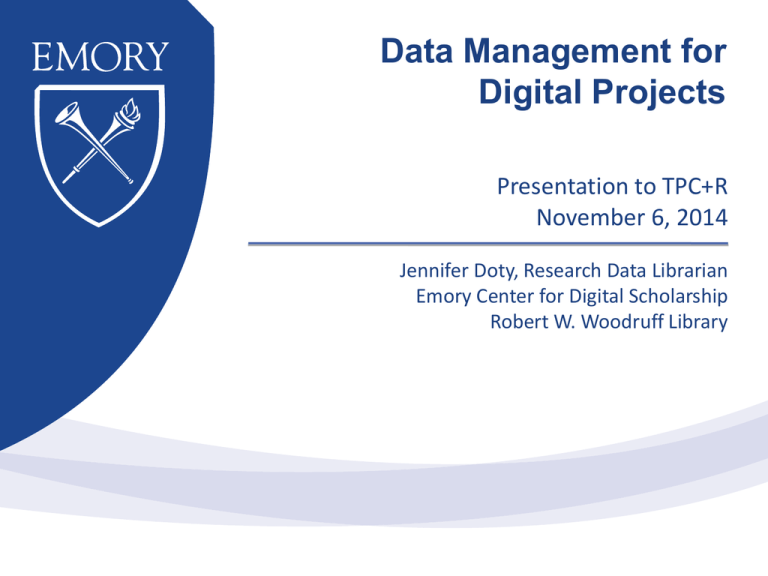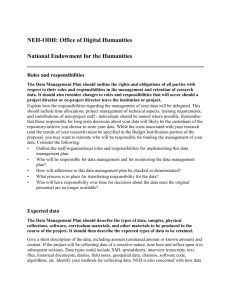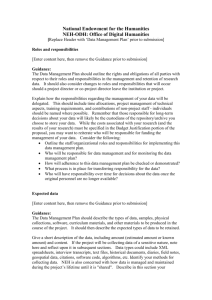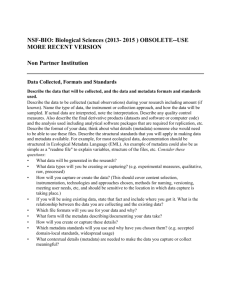Data management
advertisement

Data Management for Digital Projects Presentation to TPC+R November 6, 2014 Jennifer Doty, Research Data Librarian Emory Center for Digital Scholarship Robert W. Woodruff Library Data Management for Digital Projects • What are Data? What is Data Management? • Why Manage Your Data? • Data Lifecycle • Best Practices for Data Management • Special Considerations What are Data? Wide variety across domains: • Physical and life sciences—data are gathered or produced by researchers, such as by observations, experiments, or models. • Social sciences—researchers may gather or produce their own data, or they may obtain data from other sources such as public records of economic activity. • Humanities—data most often are drawn from records of human culture, whether archival materials, published documents, or artifacts. Borgman, C. L. (2011). The Conundrum of Sharing Research Data. Journal of the American Society for Information Science and Technology, 63(6), 1–40. doi:10.2139/ssrn.1869155 What is Data Management? “Data management covers all aspects of handling, organising, documenting and enhancing research data, and enabling their sustainability and sharing.” (UK Data Archive) Why Manage Your Data? Consider this case study: A scholar with the Center for Advanced Study in the Behavioral Sciences at Stanford lost all three copies of his fieldwork notes, representing decades of research, when the center’s offices were firebombed in 1970. Case study: Data storage and backup. Stanford University Libraries, Data Management Services. https://library.stanford.edu/research/data-management-services/case-studies/case-study-data-storage-and-backup Data Lifecycle data creation Before Data Creation • data re-use data processing • Plan data management (file formats, storage locations, etc.) Locate existing data During Data Creation data sharing data analysis data preservation • • Capture and create metadata Back-up data Best Practices: File Formats • All digital data are dependent on software, and thus all data are endangered by obsolescence • Safest option to guarantee long-term usable data is to convert to open and standard formats that most software are capable of interpreting UK Data Archive File Formats & Software, http://www.data-archive.ac.uk/create-manage/format/formats Best Practices: File Formats Type of data Acceptable formats for sharing, reuse and preservation Other acceptable formats for data preservation Digital image data • TIFF version 6 uncompressed (.tif) • JPEG (.jpeg, .jpg) but only if created in this format • TIFF (other versions) (.tif, .tiff) • Adobe Portable Document Format (PDF/A, PDF) (.pdf) • standard applicable RAW image format (.raw) • Photoshop files (.psd) Digital audio data • Free Lossless Audio Codec (FLAC) (.flac) • MPEG-1 Audio Layer 3 (.mp3) but only if created in this format • Audio Interchange File Format (AIFF) (.aif) • Waveform Audio Format (WAV) (.wav) Digital video data • MPEG-4 (.mp4) • motion JPEG 2000 (.mj2) Documentation and scripts • • • • Rich Text Format (.rtf) PDF/A or PDF (.pdf) HTML (.htm) OpenDocument Text (.odt) • plain text (.txt) • some widely-used proprietary formats, e.g. MS Word (.doc/.docx) or MS Excel (.xls/.xlsx) • XML marked-up text (.xml) according to an appropriate DTD or schema, e.g. XHMTL 1.0 UK Data Archive File Formats Table, http://www.data-archive.ac.uk/create-manage/format/formats-table Best Practices: Storage Tape library, CERN, Geneva by Cory Doctorow / CC BY-SA 2.0 Best Practices: Storage Storage Considerations: • Accessibility • Read/Write speed • Size limits—overall vs. file size Options: • Local—PC drive, flash drive, external hard drive • Server—department/organization server space • Cloud—Box, Dropbox, Google Drive, etc. 10 emory.box.com emory.box.com • 25GB storage per user (5GB file size limit) • Login with your Emory ID and password • Collaborative sharing and editing of files— Emory and external users • Sync with mobile devices and desktop computers • Some types of sensitive data allowed (see Rules)—never FISMA or PCI Best Practices: Security Security, http://www.xkcd.com/538/ Best Practices: Security Method for strong password selection: 1. Pick a favorite book/movie title or a familiar phrase: One Flew Over the Cuckoo’s Nest 2. Take the first letter of every word (include or add punctuation): ofotc’sn 3. Add some random capitalization and numbers to reach 8+ characters: 1fotC’sN75! Metadata is a love note… by sarah0s / CC BY-NC-ND 2.0 Best Practices: Documentation Best Practices: Documentation Basic metadata characteristics: Who • Who created the data What • What the data file contains When • When the data were generated Where • Where the data were generated Why • Why the data were generated How • How the data were generated Best Practices: Documentation • What contextual details (metadata) are needed to make the data you capture or collect meaningful? • What form will the metadata describing & documenting your data take? • How will you create or capture these details? • Which metadata standards will you use and why have you chosen them? IMLS Summary of Research and Data, Metadata section, https://dmptool.org/requirements_templates/40/basic.rtf Data Lifecycle data creation data re-use Data Processing & Analysis data processing • • • • data sharing data analysis data preservation Transcribe/digitize data Check, validate, and clean data (document the process) Organize data (file naming system, file organization, etc.) Back-up data Best Practices: File Naming • • • • Avoid using special characters (& % @ \ /). Use under_scores instead of periods or spaces. Err on the side of brevity (<25 characters). Include all necessary descriptive information independent of where it is stored. • Include dates, format consistently. • Include a version number when applicable. • Be consistent. Adapted from http://www.records.ncdcr.gov/erecords/filenaming_20080508_final.pdf Best Practices: File Naming Descriptive Information: • If the following files were pulled out of their individual folders, they would appear to be the same file: \World_War_I\Posters\Owens\0001.tif \World_War_I\Posters\RedCross\0001.tif 0001.tif lacks context, but wwI_poster_owens_0001.tif contains all necessary descriptive information Best Practices: File Naming Date & Time Formats: • The best way to list the date is based on an international standard (e.g. ISO 8601): YYYY_MM_DD or YYYY-MM-DD or YYYYMMDD November 6, 2014 becomes 20141106 • The best way to list the time is to use 24-hr notation: HH:MM:SS or HHMMSS (include time zone) 4:05pm (in Atlanta, after 1st Sunday in November) becomes 16:05:00EST Best Practices: File Naming Versioning: • useful to indicate file revisions or edits, especially in collaborations • can be through discrete or continuous numbering, depending on minor or major revisions (think of software versioning) – CoolProgram 2.0 is significant change from 1.4, but CoolProgram 2.1 is (relatively) minor change to 2.0 24 Best Practices: Back-up Back-up Considerations: • Accessibility—local, server, cloud • Redundancy—3 copies, geographically distributed (here, near, far) • Frequency—incremental and full, automated if possible Old Files, http://www.xkcd.com/1360/ Data Lifecycle data creation data re-use Data Preservation data processing • • • • • data sharing data analysis data preservation Choose what data to preserve Anonymize data, if needed Migrate data to best format (uncompressed, non-proprietary file formats) Finalize metadata Choose most appropriate place to archive datasets Best Practices: Preservation • Should all data be preserved? • Should data be preserved in its original/raw state, or after it has been transformed? – access copies vs. archival objects • Which file formats should be used for long-term preservation? • What description or contextual information (metadata) should accompany data to make them meaningful to others in the future? • Where will data be preserved? Is that location stable and likely to endure? Open Access to data Terms of use & licensing of data Persistent identifier Certified or supports standard Data Lifecycle data creation Data Sharing & Re-Use data re-use data processing data sharing data analysis data preservation • • • • • • Publish data (data can be cited) Control access Replicate research Propose new research questions Meta-analysis Use as teaching resources Special Considerations • Content in web systems – Backing Up Your Database (for WordPress) – Exporting/Archiving Courses (for Blackboard) • Sustainability – “Health Check” Tool for Digital Content Projects Green Question Mark by mikecogh on Flickr / CC BY Thank You! Jen Doty jennifer.doty@emory.edu





